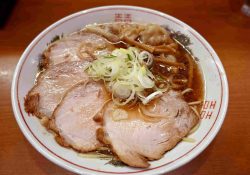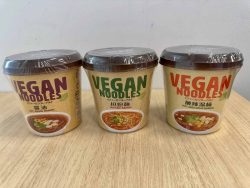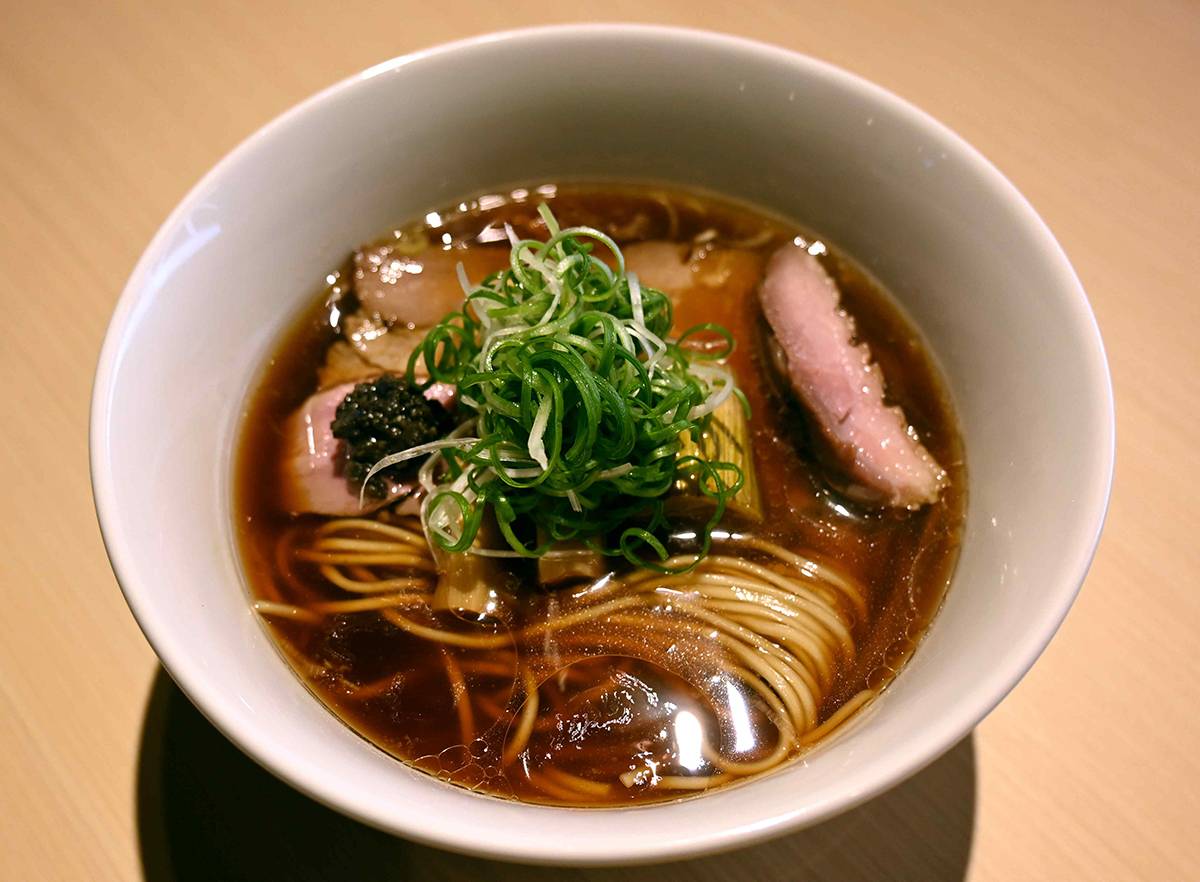
Kamo Chukasoba (shoyu) — ¥1,130
12:41 JST, August 17, 2023
Let’s start with a question: What do the following have in common? Kishu kamo (Kishu duck), Yuasa shoyu (Yuasa soy sauce) and grape sansho (grape pepper).
The answer? They’re all produced in the Arita region of central Wakayama Prefecture.
Ramen outlet Kamo Chukasoba Kaede in Hachioji, Tokyo, prides itself on a harmonious, palate-pleasing ramen dish that leverages all three of these Arita-sourced ingredients.
After initially visiting the store as a casual customer, I was so impressed that I later returned to interview the owner.
The store — whose motto is “To become a ramen shop that expands the circle of smiles”
— is a mere two minute-walk from Keio Hachioji Station and celebrated its second anniversary in July.
-

Exterior view of Kamo Chukasoba Kaede, near Keio-Hachioji Station in Tokyo
-
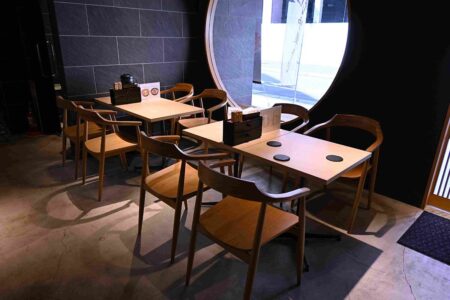
Table seating situated by a novel round window
-

Seats and tables inside the shop
-
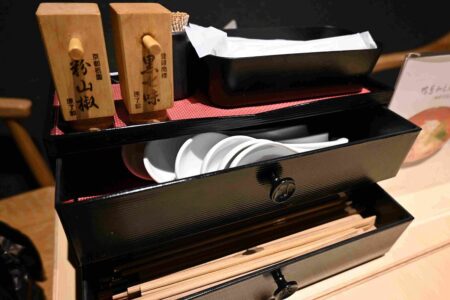
Chopsticks and Renge ramen spoons are placed in small drawers on each table.
-
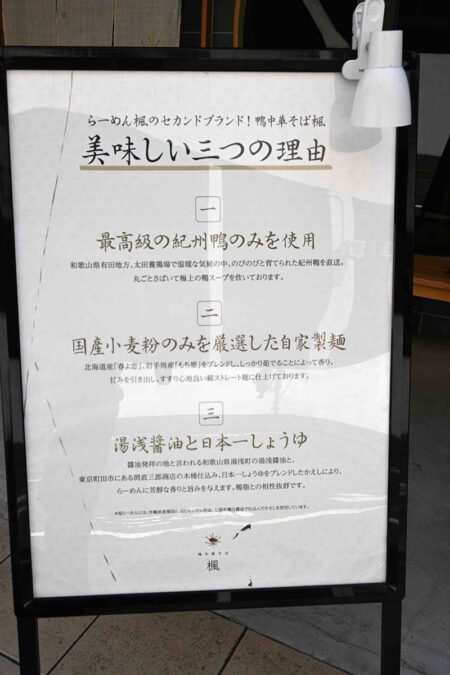
A sign in front of the shop explains the outlet’s special ramen.
-
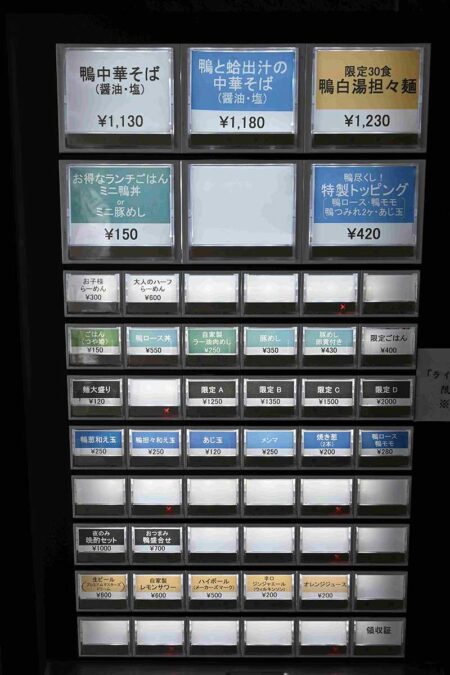
A ticket machine in front of the store
-
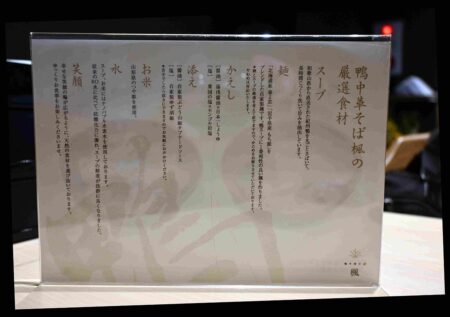
Text explaining about the ingredients used in the shop’s ramen
Occupying the first floor of an apartment building, it features three tables, a kitchen-facing counter and a noodle-making room in the corner.
The spacious outlet also boasts a refined exterior and interior, evoking the vibe of a kaiseki cuisine restaurant. I ventured inside after using the external ticket machine to order the shop’s signature dish: Kamo Chukasoba (¥1,130).
Upon entering, I was greeted by Keijiro Takiya, the shop’s manager.
The kamo chukasoba is available with shio (salt) or shoyu (soy sauce) flavors — I plumped for the shoyu option. Takiya prepared three slices of chashu on a cutting board. “It’s a combination of Kishu duck breast, thigh, and pork shoulder,” he explained, prior to preparing the noodles and soup.
-
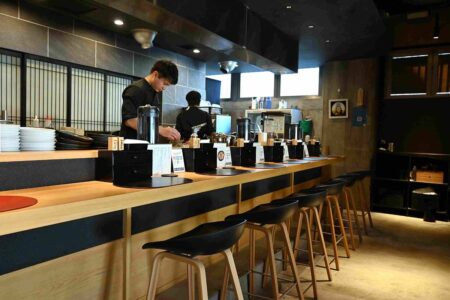
Takiya prepares ramen in the shop kitchen.
-
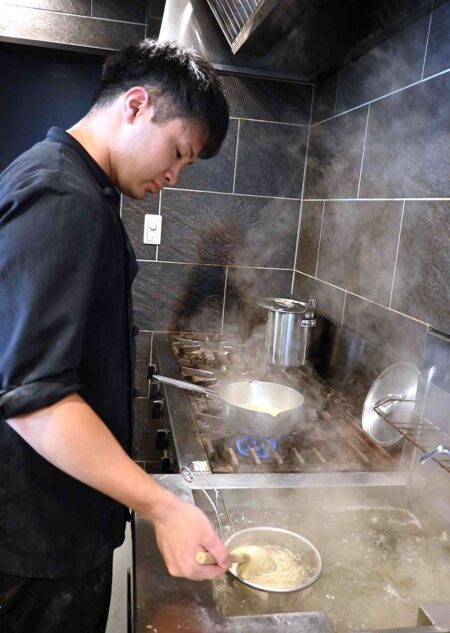
The thin noodles only take about 50 seconds to cook.
-
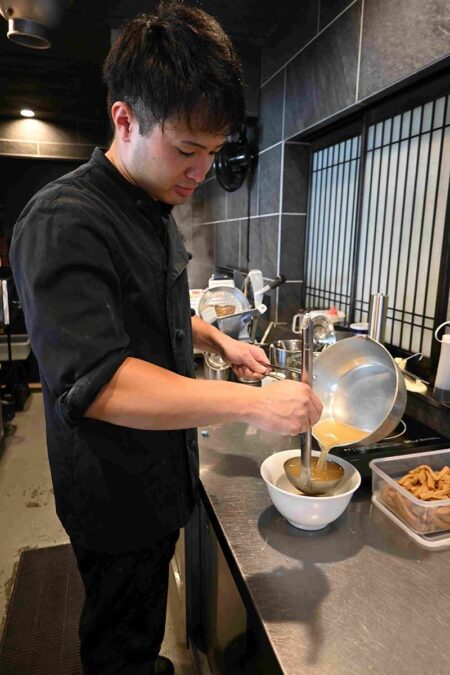
Filling a bowl with soup
-
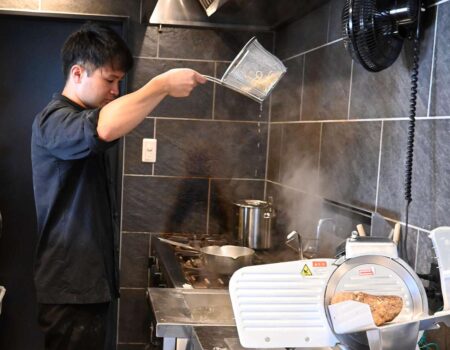
Takiya drains the water from boiled noodles.
-

Preparing the clear duck-flavored soup
-
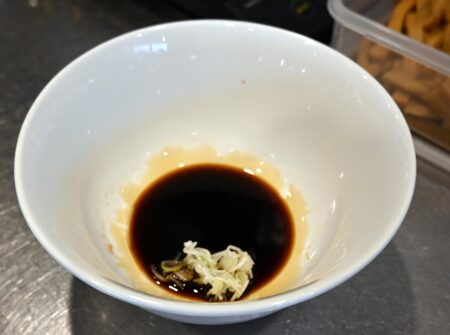
Kaeshi sauce blended with Yuasa Shoyu and Nihonichi Shoyu
-
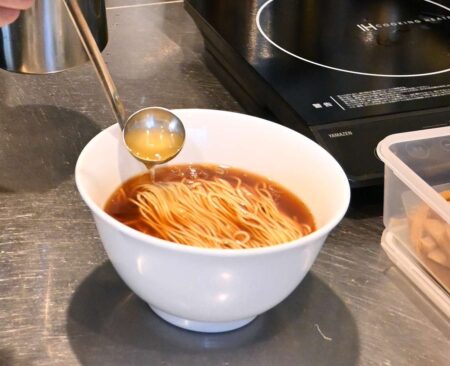
Homemade duck oil is added as a final touch.
-

Noodles are neatly arranged in a bowl
Takiya added the thin, quick-cooking noodles to a bowl containing soup, then garnished the dish with toppings. When the dish was placed on the table, the first thing that struck me was the soup’s color. The clear-brownish broth was patently crafted from high-quality duck and gave off a rich umami flavor.
The liquid had a deep, appealing taste with a delicate hint of duck. The shoyu flavor was also worth writing home about. According to Takiya, 25, the shop’s soup combines seafood broth and oil from the duck — the latter added as a finishing touch.
The shoyu used for the kaeshi sauce blends Yuasa shoyu from the Arita region and Nihon-ichi shoyu. The homemade noodles — freshly made each morning — complemented the duck broth delightfully.
-

The thin homemade noodles complement the soup delightfully.
-

Tasty duck chashu
-
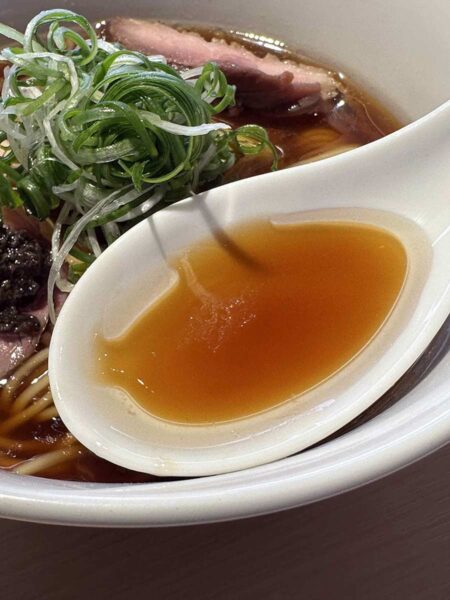
The clear duck-flavored soup also contains some seafood broth.
While tucking into my meal, the shop’s owner, Haruki Inokawa, 43, appeared with a beaming smile. “Kishu duck is one of the tastiest ducks in Japan,” he opined. “It has almost no odor yet brims with umami and deep flavors.”
The shop, which buys in whole Kishu ducks, uses the breast and thigh meat for chashu, and the remainder for the soup.
“Kishu duck, Yuasa shoyu and grape sansho blend well because they were all raised using the same water in the area,” Inokawa explained.
-
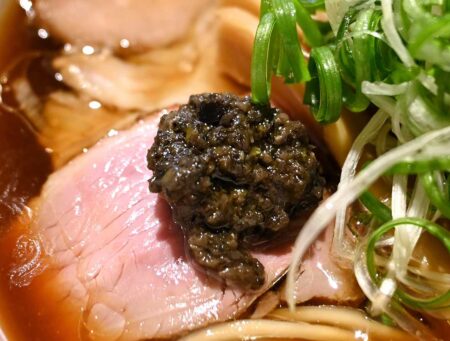
The tapenade with grape sansho (Japanese pepper) has a unique flavor.
-
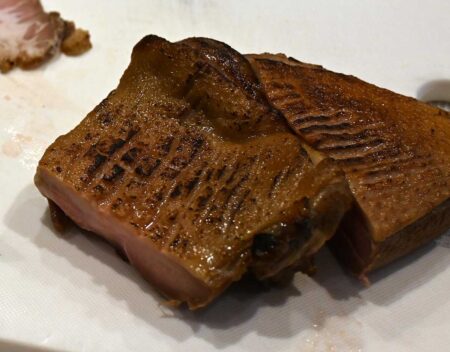
Duck chashu made with yuan-yaki
-
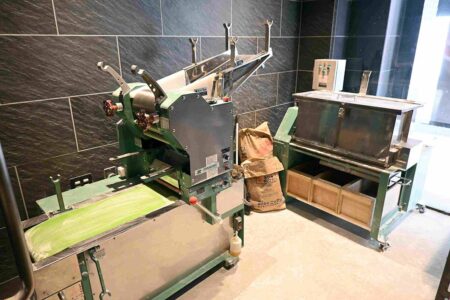
The outlet has its own noodle-making room.
-
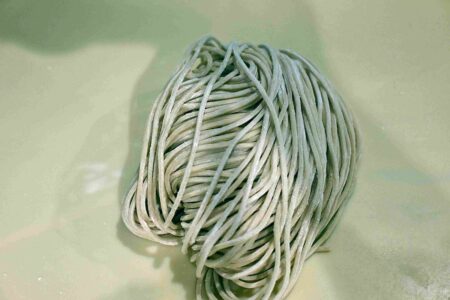
The shop’s noodles are freshly made in-house each morning.
The grape pepper comes in a paste form known as tapenade, which originated in France. The outlet’s homemade tapenade comprises olives, anchovies, garlic and grape sansho, and is used to top the ramen noodles. The mix of the Western paste and the Japanese pepper imbues the elegantly presented ramen with a delicate accent, giving rise to a uniquely flavored dish.
In Japan, duck and leek are known for going well together, and ramen bowls — of varying flavors— often include grilled leek.
“[Duck and leek] are a classic combo,” said Inokawa. “But our recipe is a little more elaborate. When we cook the duck, we roast it with yuan (seasoning sauce) and we marinate the grilled leeks in the sauce, which is imbued with flavors extracted from the duck meat.”
It was at that point that I understood why the shop’s leeks tasted so delicious.
-
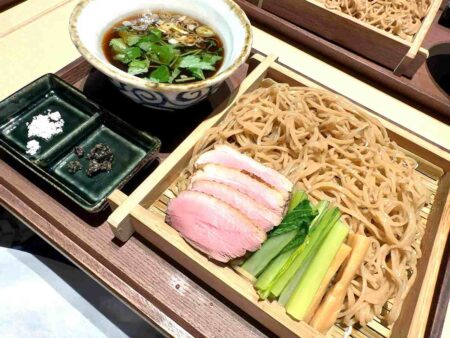
A summer-only tsukemen dish, with duck seiro and rye noodles (¥1,500)
-
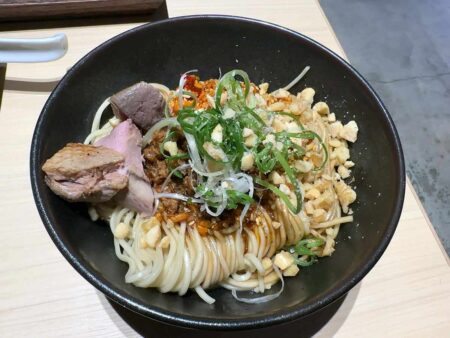
An extra serving of duck and green onion noodles costs ¥250.
My first visit to Kamo Chukasoba Kaede was inspired by a post on the shop’s X (formerly Twitter) account, announcing the availability of its special summer dish, Kamo seiro with rye noodles (¥1,500).
The homemade rye noodles had a delightful aroma and were delicious on their own with just a sprinkling of salt. The tsukemen (noodle-dipping) soup was tasty, too, and I finished the dish off by adding soup-wari (extra soup stock). The special dish, which is available until mid-September, is also highly recommended.
Smile-inducing ramen

Shop owner Haruki Inokawa (left), and shop manager Keijiro Takiya
Inokawa also runs Ramen Kaede, a 15-minute walk from Kamo Chukasoba Kaede.
“To mark Ramen Kaede’s 16th anniversary, I produced a ramen dish using Kishu duck and was very impressed by the taste,” Inokawa explains. “It was so different from the duck I was familiar with, prompting me to open my second shop (Kamo Chukasoba Kaede) in July 2021 to specialize in Kishu duck dishes.
Inokawa, who trained at Menya Musashi — a celebrated ramen outlet in the capital’s Shinjuku Ward — opened his first ramen shop 20 years ago, at the age of 24, fulfilling a long-held ambition.
Believing that gaining experience working in Italian restaurants would help him create novel ramen dishes, he applied for a job at an Italian restaurant as a career after university graduation.
However, he was turned down on the basis that the restaurant did not hire a college graduate. Later, however, he found employment at Menya Musashi after noticing a sign that read “staff wanted.”
Inokawa worked at Menya Musashi for 18 months before opening his first eatery in Hachioji, in a property that previously operated as a ramen shop.
Though he initially served ramen with pork and seafood mixed soup, he now concentrates on jidori chicken and bonito mixed soup. The shop has many regular customers.
-

The central kitchen in the back of the shop
-
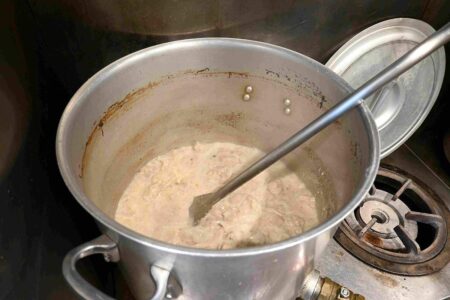
Duck-flavored white soup made in the central kitchen
At Kamo Chukasoba Kaede, there is a huge central kitchen in the back separate from the kitchen facing the counter. “I built this kitchen with the intention of opening two or three more outlets,” Inokawa said. “I’d like to create more ramen shops in the Tama area, which includes Hachioji.”
The shop’s motto is “smile.” “The motto originated with my mother’s smile,” Inokawa explained “Looking back, all I can remember is her smile. You can’t argue with a smile on your face; you can’t fight a war with a smile on your face. I’d like to see a peaceful world without conflict. With these thoughts in mind, I want to spread smiles through the medium of ramen.”
I could sense Inokawa’s sentiment through the taste of his ramen, and the shop’s service and appearance.

The shop’s logo (inspired by kaede, meaning “maple” in Japanese)
Intrigued by the “Kaede” element of the outlets’ names, I asked Inokawa where the name came from. “I’m a huge fan of [renowned Japanese pop-rock band] Spitz, and I named the shop after their song ‘Kaede,’” he explained.
Inokawa continues striving to create ramen dishes that put a smile on his customers’ faces, while quietly hoping that the members of Spitz will someday sit at his counter.
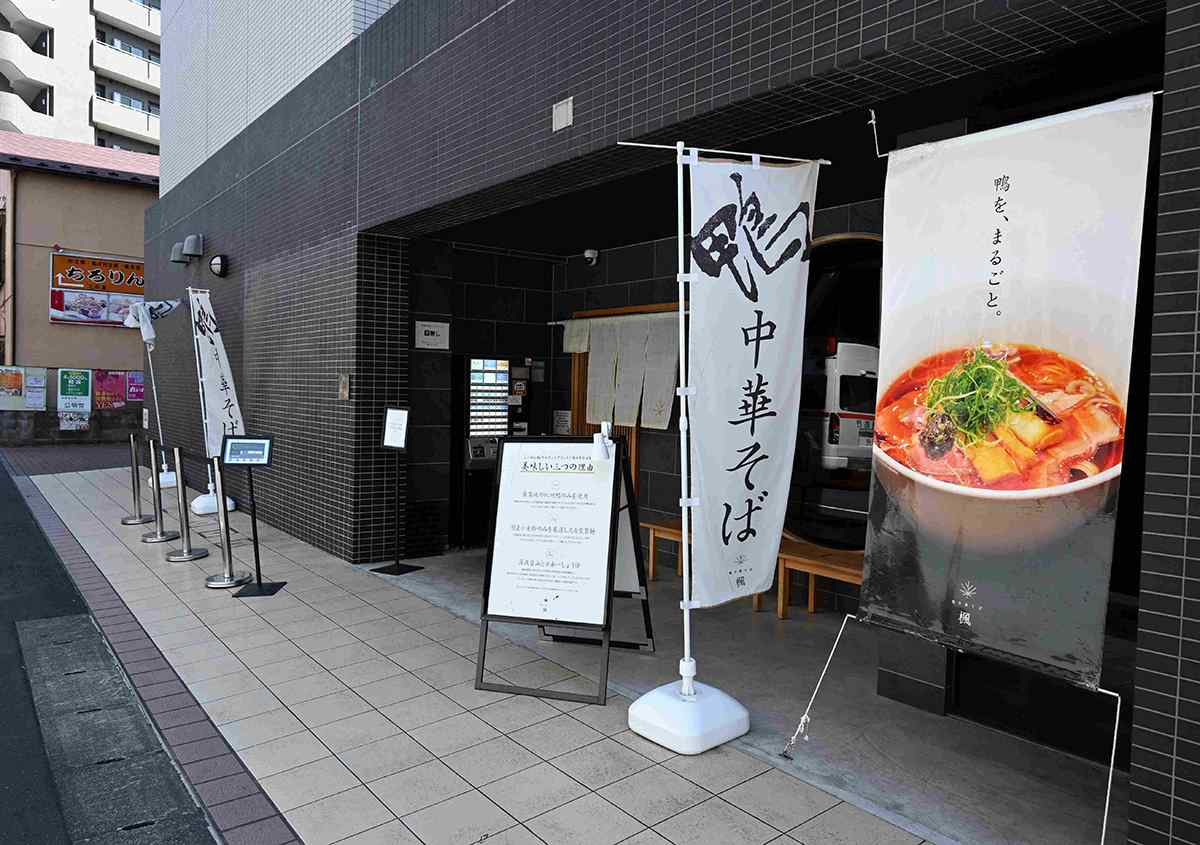
Kamo Chukasoba Kaede
Address: 3-24-12 Myojincho, Hachioji, Tokyo. Lunch: 11 a.m. to 2:30 p.m. Dinner: 5:30 p.m. to 10 p.m. No regular holidays. For more information, visit the shop’s website at https://kaede.fan/ (Japanese only).
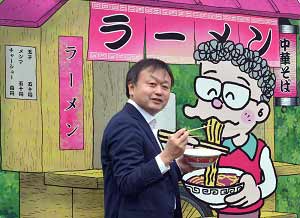
Futoshi Mori, Japan News Senior Writer
Food is a passion. It’s a serious battle for both the cook and the diner. There are many ramen restaurants in Japan that have a tremendous passion for ramen and I’d like to introduce to you some of these passionate establishments, making the best of my experience of enjoying cuisine from both Japan and around the world.
Japanese version
【ラーメンは芸術だ!】「鴨中華そば 楓」の笑顔になる一杯、和歌山の高級食材が奏でるハーモニー

"JN Specialities" POPULAR ARTICLE
-

The Japan News / Weekly Edition (12/12-12/18)
-

English-language Kabuki, Kyogen Entertain Audiences in Tokyo; Portland State University Professor Emeritus, Graduates Perform
-

Noodle Dining Shunsai / Rich Oyster Ramen to Savor at Odasaga; Experienced 68-year-old Owner Creates Numerous Ramen Varieties
-

The Japan News / Weekly Edition (12/5-12/11)
-

People Keep Loved Ones’ Ashes Close in Special Jewelry, Small Urns as Unique Way to Memorialize Them
JN ACCESS RANKING
-

Keidanren Chairman Yoshinobu Tsutsui Visits Kashiwazaki-Kariwa Nuclear Power Plant; Inspects New Emergency Safety System
-

Imports of Rare Earths from China Facing Delays, May Be Caused by Deterioration of Japan-China Relations
-

Tokyo Economic Security Forum to Hold Inaugural Meeting Amid Tense Global Environment
-

University of Tokyo Professor Discusses Japanese Economic Security in Interview Ahead of Forum
-

Japan Pulls out of Vietnam Nuclear Project, Complicating Hanoi’s Power Plans



